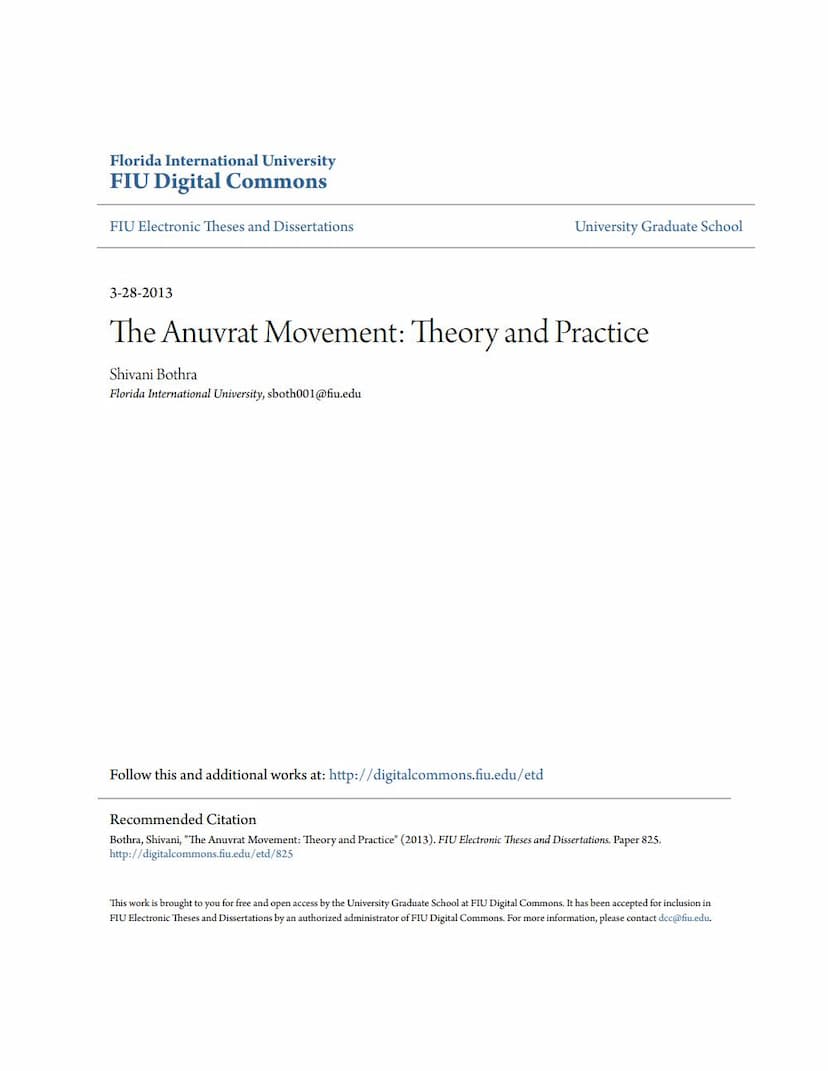Anuvrat Movement Theory And Practice
Added to library: September 1, 2025
Loading image...

Summary
This thesis, "The Anuvrat Movement: Theory and Practice" by Shivani Bothra, published by Florida International University in 2013, examines the Anuvrat Movement initiated by Acharya Tulsi of the Jain Svetambar Terapanth tradition. The movement's core philosophy is encapsulated by the slogan "Self-restraint is life."
Key aspects of the thesis:
- Origin and Vision: The movement emerged in post-independence India as a response to the perceived moral and character decline brought about by modernization. Acharya Tulsi, a respected Jain monk, aimed to regenerate Indian society through individual self-transformation, drawing from the Jain principles of ahimsa (non-violence), aparigraha (non-possession), and anekant (non-absolutism). He reinterpreted these principles to create a secular, ethical movement accessible to people of all faiths.
- The Anuvrat Vows: The thesis analyzes the eleven modified vows formulated by Acharya Tulsi, which are based on the traditional Jain vows for lay followers (anuvrat). These vows cover a wide range of contemporary issues including non-violence, non-aggression, unity, religious toleration, business rectitude, limiting acquisition, ethical conduct in elections, rejecting social evils, abstaining from addictions, and environmental protection. The study explores the contemporary relevance and effectiveness of these vows in Indian society.
- Methodology: The research employs a multi-disciplinary approach, combining historical, ethnographic, and sociological methods. This included extensive literature review, thirty-nine interviews with Jain monks, nuns, and laypeople in India, and nine interviews with Jain practitioners and scholars in the United States. A sociological survey of 200 Indians was also conducted to gather data on attitudes and behaviors related to the movement.
- Comparison with Other Movements: The thesis contextualizes the Anuvrat Movement by comparing it with other concurrent pan-Indic movements inspired by Mahatma Gandhi, such as the Bhoodan Movement, the Sri Lankan Sarvodaya Shramadana Movement, and the Chipko Movement. It highlights similarities in their focus on non-violence, social justice, and spiritual foundations, as well as differences in their specific approaches.
- Role of Meditation and Ascetics: The study discusses the integration of Preksha Meditation into the Anuvrat Movement as a tool for self-discipline and inner transformation. It also examines the role of Jain monks and nuns as exemplars and guides in promoting the movement's ideals, drawing parallels with Buddhist bhikkhus in the Sarvodaya movement.
- Contemporary Effectiveness and Diaspora: The research critically analyzes the current effectiveness of the Anuvrat vows, noting that while the movement was successful under Tulsi's charismatic leadership, its impact has somewhat waned. The study also investigates the relevance and reception of the Anuvrat Movement among the Jain diaspora in North America, finding less awareness but a potential for its secular and ethical principles to resonate with younger generations.
- Key Findings and Conclusion: The thesis concludes that while the Anuvrat Movement's original specific purpose of creating social change through vows might have diminished in effectiveness over time, Acharya Tulsi's underlying belief in applying Jain principles for the betterment of secular society remains relevant. The study suggests that initiatives like Preksha Meditation and the "Science of Living" program continue to gain popularity. It also highlights the importance of charismatic leadership and the role of exemplars in the success and longevity of social movements. The research points to the need for continued examination and adaptation of Tulsi's ideas to remain relevant in contemporary times, both in India and globally.
In essence, Shivani Bothra's thesis provides a comprehensive overview of the Anuvrat Movement's theoretical underpinnings, its historical development, its practical application through vows, and its contemporary relevance and challenges, both within India and among the global Jain diaspora.